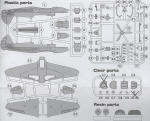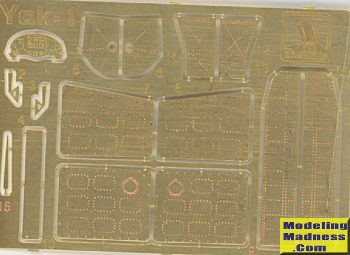
Brengun 1/72 Yak-1 (1941)
| KIT #: | BRP72020 |
| PRICE: | $16.00 |
| DECALS: | Four options |
| REVIEWER: | Scott Van Aken |
| NOTES: | Short run |

| HISTORY |
The Yakovlev Yak-1 (Russian: Яковлев Як-1) was a World War II Soviet fighter aircraft. Production began in early 1940. It was a single-seat monoplane with a composite structure and wooden wings.
The Yak-1 was manoeuvrable, fast and well armed, and it was easy to maintain and reliable. It formed an excellent basis for subsequent developments from the Yakovlev bureau. It was the founder of a family of aircraft, with some 37,000 being built. As a reward, designer Alexander Yakovlev was awarded the Order of Lenin (Russian: Орден Ленина, Orden Lenina) - the highest decoration bestowed by the Soviet Union - a 100,000 ruble prize, plus a Zis motor car.
At the time of the German invasion of Soviet Union on 22 June 1941, 425 Yak-1s had been built, although many were en route or still disassembled. 92 machines were fully operational in the Western Military Districts, but most were lost in the very first days of the war. The Yak-1 was designed with the goal of providing direct coverage of the Il-2 attack planes from enemy fighters. Thus, most of the air combat took place below 4,000 m (13,123 ft), at low altitudes where the Yak-1 performed the best. The Yak-1 proved to have a significant advantage over its Soviet competitors. A full circle turn took just 17 seconds in the Yak-1M. The MiG-3, which had the best high-altitude performance, did poorly at low and medium altitudes, and its light armament made it unsuitable even for ground attack. The LaGG-3 experienced a significant degradation in performance (as much as 100 km/h/62 mph on some aircraft) compared to its prototypes due to the manufacturer's inexperience with its special wooden construction, which suffered from warping and rotting when exposed to the elements. The Yak-1's plywood covering also suffered from the weather, but the steel frame kept the aircraft largely intact.
The aircraft's major problem early in deployment was fuel leaks caused by failure of spot-welded fuel tanks from vibration. Also troublesome was the fact that the canopy could not be opened under certain conditions in earlier models, potentially trapping the pilot in a falling aircraft. As a result, some pilots had the sliding portion of the canopy removed altogether. The first 1,000 Yak-1s had no radios. Installation of radio equipment became common by spring 1942 and obligatory by August 1942. But Soviet radios were notoriously unreliable and short-ranged, so they were frequently removed to save weight.
Like the Rolls-Royce Merlin float carburetor-equipped engines, the M-105 could not tolerate negative G forces which starved it of fuel. Moreover, they suffered breakdowns of magnetos and speed governors and emitted oil from the reduction shaft.
The Yak-1 was better than the Bf 109E, but inferior to the Bf 109F - its main opponent - in rate of climb at all altitudes, although it could complete a circle at the same speed (20–21 seconds at 1,000 meters). In comparison, a Bf 109, with its automatic wing slats, had a lower stall speed and was more stable in sharp turns and vertical aerobatic figures. A simulated combat between a Yak (with M-105PF engine) and a Bf 109F revealed that the Messerschmitt had only marginally superior manoeuvrability at 1,000 meters (3,300 ft), though the German fighter could gain substantial advantage over the Yak-1 within four or five nose-to-tail turns. At 3,000 meters (9,800 ft), the capabilities of the two fighters were nearly equal, as combat was essentially reduced to head-on attacks. At altitudes over 5,000 meters (16,400 ft), the Yak was more manoeuvrable. The engine’s nominal speed at low altitudes was lowered to 2,550 rpm, and the superiority of the Bf 109F at these altitudes was reduced.
The Yak-1's armament would be considered too light by Western standards, but was typical of Soviet aircraft, the pilots preferring a few guns grouped on the centerline to improve accuracy and reduce weight. Wing guns were rarely used on Soviet fighters, and when they were used, they were often removed (as they were from US-supplied Bell P-39 Airacobras). Avoiding wing guns reduced weight and demonstrably improved roll rates (the same was true of the Bf 109F). Typical of wartime production fighters, the type was continually improved. Later types (Yak-7/9) were basically the same airframe as the Yak-1.
| THE KIT |
 I'm
going to go out on a limb and say that this kit is molded by Brengun, but you
know otherwise, please let me know. Molding is quite good, but it is a short run
kit. I found some flash on parts but really not all that much. It is app
I'm
going to go out on a limb and say that this kit is molded by Brengun, but you
know otherwise, please let me know. Molding is quite good, but it is a short run
kit. I found some flash on parts but really not all that much. It is app arent
that there are other boxings by the crossed out bits on the sprue. Indeed,
Brengun does at least two more boxings of this same base kit.
arent
that there are other boxings by the crossed out bits on the sprue. Indeed,
Brengun does at least two more boxings of this same base kit.
Typical of the genre, there is an etched fret and while not shown, there are two small resin sprues for the wheels and radiator. The photo etch covers things like the instrument panel (and there is an acetate sheet for instruments), the seat brace, landing gear doors, underwing panels (which takes up a lot of the fret), and a floor brace. Oddly, no belts are included.
In the cockpit the seat is in two pieces and fits atop the p.e. braces that fit against the rear bulkhead. For the floor there are several sections that fit together to form this. Then this piece, the seat piece and the instrument panel piece are fit into a fuselage half, along with several sidewall boxes and the tail gear attachment point before the halves are closed. I should note that there is a lot of framework detail on the inside of the fuselage halves.
With the fuselage together, one then inserts the forward radiator piece into the lower cowling and then it and the upper cowling are attached. Tailplanes need the mounting tabs trimmed back about 75% prior to installation. On the lower wing one installs the fishhook shaped pieces to make up the main gear well and attaches all the p.e. plates to the underside. Once this is done and attached, the three piece lower radiator bath is glued on. At the back, the lower fuselage insert is put into place.
Landing gear is well done and rather complex. Gear doors are
photo etch so they are quite prototypical in their thinness. One thing I don't
like is that the exhaust stacks are separate and very small. However, these can
be attached near the end of the build as they are inserted into separate dimples
on the cowling. Wingtip lights and landing lights are provided on the clear
sprue along with a tail light housing. The cockpit clear bits are a windscreen,
canopy and backlight.
 On the 1941 build, this latter piece is a solid section of plexiglas as you'd see for the backlight on a Yak-7.
On the 1941 build, this latter piece is a solid section of plexiglas as you'd see for the backlight on a Yak-7.
Instructions are well drawn and provide generic color information. Four markings options are provided and the painting guide on the back of the box shows them all in olive green/black over light blue. Patterns are all different and the planes differ only in the tactical number that they wear. The decal sheet is well done and should prove to be quite thin.

| CONCLUSIONS |
1/72 Soviet modelers know that there is a dearth of Yak-1 kits in this scale. While the Yak-3 has had a number kits produced by the 'big boys', the -1 has still not gained their attention. Fortunately, for those who have the skills, there are kits readily available and they are not pricey
| REFERENCES |
https://en.wikipedia.org/wiki/Yakovlev_Yak-1
February2018 Copyright ModelingMadness.com. All rights
reserved. If you would like your product reviewed fairly and fairly quickly, please
contact
the editor or see other details in the
Note to
Contributors. Back to the Main Page
Back to the Review
Index Page
Back to the Previews Index Page